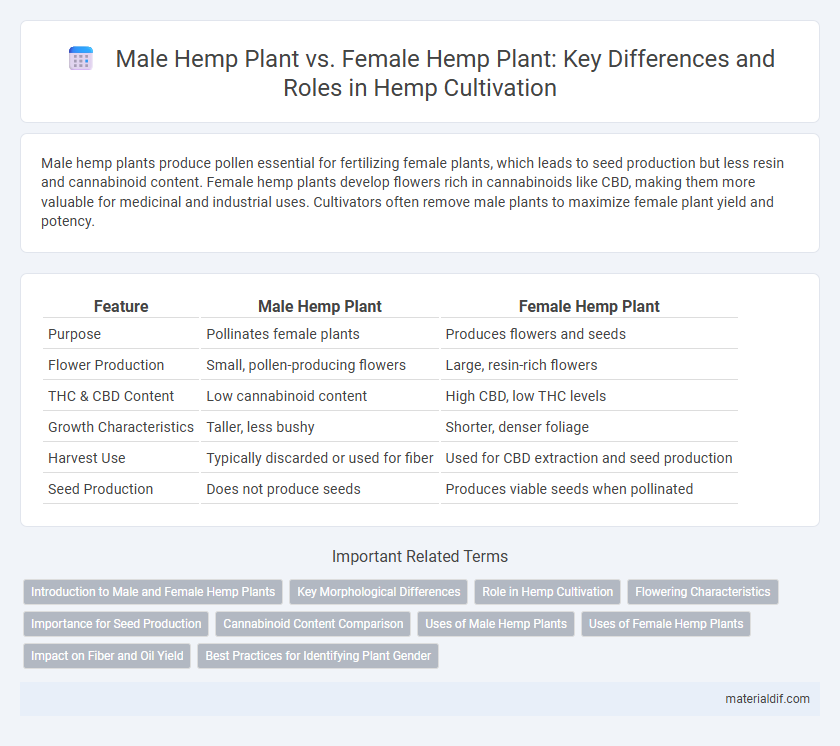Male hemp plants produce pollen essential for fertilizing female plants, which leads to seed production but less resin and cannabinoid content. Female hemp plants develop flowers rich in cannabinoids like CBD, making them more valuable for medicinal and industrial uses. Cultivators often remove male plants to maximize female plant yield and potency.
Table of Comparison
| Feature | Male Hemp Plant | Female Hemp Plant |
|---|---|---|
| Purpose | Pollinates female plants | Produces flowers and seeds |
| Flower Production | Small, pollen-producing flowers | Large, resin-rich flowers |
| THC & CBD Content | Low cannabinoid content | High CBD, low THC levels |
| Growth Characteristics | Taller, less bushy | Shorter, denser foliage |
| Harvest Use | Typically discarded or used for fiber | Used for CBD extraction and seed production |
| Seed Production | Does not produce seeds | Produces viable seeds when pollinated |
Introduction to Male and Female Hemp Plants
Male hemp plants produce pollen essential for fertilizing female plants, enabling seed production, while female hemp plants develop flowers rich in cannabinoids like CBD and THC. The distinct biological roles influence cultivation practices; growers often remove males to prevent pollination and maximize resin production in females. Understanding the sexual dimorphism in hemp plants is crucial for optimizing yield quality and cannabinoid concentration in commercial hemp cultivation.
Key Morphological Differences
Male hemp plants typically exhibit taller, more slender stems with fewer leaves, producing pollen sacs that resemble small clusters or balls. Female hemp plants have shorter, bushier structures with dense leaves and develop resin-rich flowers or buds essential for cannabinoid production. The absence of pollen sacs and the presence of pistils--hair-like structures on flowers--are key identifiers distinguishing female plants from males.
Role in Hemp Cultivation
Male hemp plants play a crucial role in hemp cultivation by providing pollen necessary for fertilizing female plants, enabling seed production for future crops. Female hemp plants are primarily cultivated for their high concentrations of cannabinoids such as CBD, essential for medicinal and commercial uses. Understanding the distinction between male and female hemp plants is vital for optimizing yield, cannabinoid content, and overall crop quality.
Flowering Characteristics
Male hemp plants produce pollen and typically flower earlier than female plants, exhibiting less dense and smaller flowers primarily used for pollen dispersal. Female hemp plants develop resinous, dense buds rich in cannabinoids, with flowering phases lasting longer to maximize trichome and cannabinoid production. The flowering period for female hemp plants ranges from 7 to 14 weeks, while male plants complete flowering faster, usually within 3 to 6 weeks, influencing overall crop yield and quality.
Importance for Seed Production
Female hemp plants are essential for seed production because they develop the flowers that produce seeds after pollination. Male hemp plants release pollen necessary for fertilizing female flowers, enabling seed formation and genetic diversity. Proper identification and management of male and female plants ensure optimal seed yield and quality in commercial hemp cultivation.
Cannabinoid Content Comparison
Male hemp plants typically exhibit lower cannabinoid content compared to female hemp plants, especially in key compounds like CBD and THC. Female hemp plants are cultivated primarily for their dense flower clusters, which contain higher concentrations of cannabinoids essential for therapeutic and industrial applications. The significant difference in cannabinoid profiles makes female hemp plants more valuable for extraction and product development in the cannabidiol market.
Uses of Male Hemp Plants
Male hemp plants play a crucial role in hemp cultivation primarily through pollen production, which is essential for fertilizing female plants and seed generation. These plants are highly valuable for producing hemp fiber, known for its strength and durability, making it ideal for textiles, rope, and paper products. While male plants contain lower concentrations of cannabinoids like CBD compared to female plants, their rapid growth and robust stalks contribute significantly to industrial hemp applications.
Uses of Female Hemp Plants
Female hemp plants produce dense, resin-rich flowers that are essential for extracting cannabidiol (CBD) oil, used medicinally and therapeutically. Their higher cannabinoid content supports applications in wellness products, cosmetics, and pharmaceuticals. Seed production also offers nutritional value and supports sustainable food markets.
Impact on Fiber and Oil Yield
Male hemp plants produce coarser fibers primarily used in textiles and rope, while female hemp plants generate finer fibers preferred for high-quality fabric production. Female plants yield more oil-rich seeds essential for CBD extraction and nutritional products, whereas male plants produce little to no seed oil. The differential fiber texture and seed oil content between male and female hemp plants directly affect their industrial applications and overall economic value.
Best Practices for Identifying Plant Gender
Male hemp plants typically produce pollen sacs, while female hemp plants develop pistils with white hairs, which are critical indicators for gender identification. Best practices for identifying plant gender include closely monitoring pre-flowers during the early vegetative stage and using magnification tools to distinguish subtle differences in reproductive structures. Accurate gender determination allows cultivators to optimize crop yield by preventing unwanted pollination and promoting the growth of resin-rich female plants.
Male Hemp Plant vs Female Hemp Plant Infographic

 materialdif.com
materialdif.com